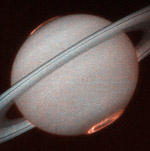
Saturn, rings and aurora
The Cassini Mission
updated July 9, 2003
by Paul Doherty
Webcasts:
July 2, 2004 Phoebe,
enigmatic moon of Saturn
July 9
2004 Rings of
Saturn
July, 16,
2004 Titan
August 21, Saturn


The first observations of the rings of Saturn were made by Galileo in 1610. He didn't know what the two blobs that he saw on either side of Saturn were. He was also surprised when they vanished two years later. When viewed from the side the rings are so thin they cannot be seen.
One early observer said that Saturn appeared to have ears.
In 1655 Christian Huygens thought that the rings
of Saturn were actually solid planar disks.
In 1856 James Clerk Maxwell figured out that the disks were made of
numerous small bodies.
The rings are in the plane of
Saturn's equator.
Most of the moons of Saturn orbit in the same plane, so the view of
the rings from most moons presents a single line through Saturn,
--O--. Only the moons Iapetus and Phoebe move above and below the
rings far enough to give a good view of the rings.
The equatorial bulge of the rotating planet stabilizes the rings. Go to equatorial bulge.
Demo Spin a Koosh, If you spin a Kooshball as you throw it into the air it will assume a shape with an equatorial bulge similar to the equatorial bulge of a rotating planet.
The rings and Saturn's equator are tipped 25 degrees from Saturn's orbital plane around the sun. So from the earth we can usually see the rings except occasionally, every 15 years or so, we see the rings edge-on and they appear to vanish.
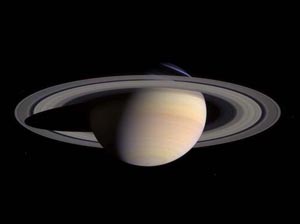
Demo Model the rings of Saturn. I used a large, 73 cm, or 32 inch, diameter fabric disk called a Beamo tm . The Beamo has a hole in the center big enough for a 12 inch diameter beach ball. I taped the beach ball into the hole. The ratio of the diameter of the beachball to the flying disk was the same as the ratio of the diameter of Saturn to the outer diameter of the bright rings, i.e. the outer edge of the A-ring. The outer edge of the A-ring is 2.3 times larger in diameter than the radius of Saturn. If this fabric ring were made to scale it would be a millionth of a meter thick, a micrometer thick, one hundred times thinner than a human hair. A 1.2 inch diameter ball is the size of the earth at this scale.
Saturn's bright rings are large but very thin, they are over 280,000 km in diameter yet only tens of meters thick. Some ring particles are larger in diameter than the thickness of the rings. The rings are a million times thinner than their diameter.
Demo To appreciate the thinness of the rings picture a football field covered with tissue paper. Tip the Beachball/frisbee model to show how the rings appear edge on as Saturn orbits the sun.
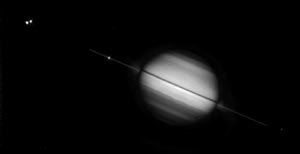
Demo The rings are made of particles that orbit Saturn in nearly circular orbits that obey Kepler's laws. A museum exhibit known as a "Gravity Well" can be used to illustrate the orbits of ring particles. Particles near the center of the well, near Saturn, orbit faster than those further from the center.
The astronomer Cassini, for whom the spacecraft is named, noted a dark band in the rings, now known as the Cassini division, which separates the outer A-ring from the inner B-ring. The rings are given letters in the order of their discovery.
Orbital Resonance
The edge of the B-ring corresponds to an orbit with a 2/1 resonance with Mimas. A ring particle at that distance orbits twice every time Mimas orbits once. The orbital disturbance grows each time as a result of resonance. Just like pushing a swing. Eventually particles are removed from the resonant gap.
Demo The gravity well can be used to show an inner orbit of a rolling marble that goes around twice for every single orbit of a rolling marble that is further from the center.
Math Root Kepler discovered that the period of an orbit, T, is related to its radius, R. By the relation
T2 = c R3 where c is a constant. Two orbits with period in a ratio of T1/T2 = 2/1 have a ratio of orbital radii of R1/R2 = (T1/T2 )2/3 = 22/3 = 1.6. So in the Gravity Well model the outer particle should orbit 1.6 times further from the center than the inner one.
The rings are richly detailed. The passage of small moons excites density waves in the rings. These are similar to spiral arms found in galaxies.
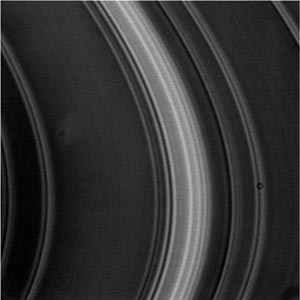
The A-ring is the home of the density waves. Moons of Saturn pull on ring particles and cause them to "bunch up" and create regions of higher and lower density. These regions get wound-up into spiral waves around Saturn. There may also be small "moons" inside the rings creating the delicate ring textures.
Demo Show a record with its spiral groove to model the finely detailed structure of Saturn's rings. Note that the record is much thicker than the rings. Sprinkle sweet-and-lo sweetener on the record to model the rings which are made of individual particles. (The record is black and becomes invisible.) Run a finger around the record to clear a path of particles and create the Cassini division. (Demo by Eric Wegryn)
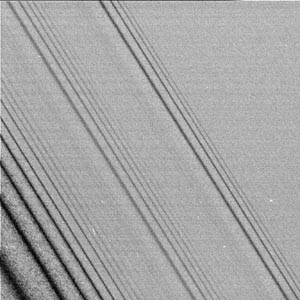
The gravitational pull of orbiting moons can also pull the particles that make-up the rings to the side making bending waves, like the corrugations in cardboard. In the following image of the A ring the waves in the lower left are density waves while the ones in the upper right are bending waves.
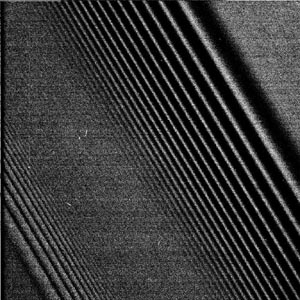
In addition to creating waves in rings, moons can also control the positions of the edges of the rings, such moons are called shepherd moons. The thin and braided F-ring has two shepherd moons, one inside and one outside of the ring
Shepherd moons
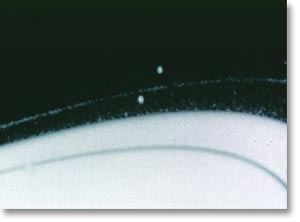
Shepherd moons flank the F-ring.
The Cassini spacecraft found that the bright rings are made of water ice, few impurities were noted. The particles range from 1 cm to 10 m in diameter, in addition, there are some larger particles up to kilometers in size and also some dust. The Cassini spacecraft did find particles in the Cassini division these darker particles were made of silicates, i.e. rock.
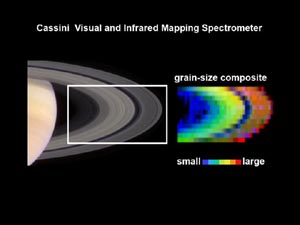
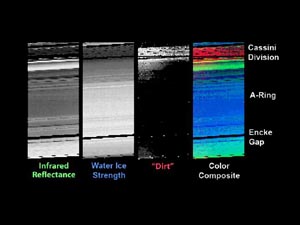
The rings are made of almost pure ice, 99% pure, but there is "dirt"
in the Cassini division.
A liquid particle will be torn apart if it within the Roche limit distance from Saturn any moon over about 100 Km in diameter behaves like a fluid, and will be torn apart within the Roche limit. Small solid particles can survive. The Roche limit for Saturn is about 2.5 times the radius of Saturn, Rs. (actually 2.456*Rs ds/dr)1/3 where ds is the density of Saturn and dr the density of the satellite. ) The bright rings are closer to Saturn than the Roche limit.
There are 3 theories of ring formation the rings are made of particles that came from:
Scientists don't know which theory is correct, if any.
Demo Tidal Forces can be modeled on the "Gravity Well" exhibit. Start two marbles touching each other near the rim of the "Gravity Well." Align the marbles along a radial line. Release them. The marbles will separate as they roll down into the well. The inner marble is closer to the center and so a stronger gravity force accelerates it toward the center. It moves toward the center faster than the outer marble leaving the outer marble behind. If the two marbles represent two rocks in space they will be pulled apart by the difference in the gravity force. This difference in the gravity force is called the tidal force. If a moon gets too close to any planet it will be pulled apart by tidal forces.
Spokes in the Rings
There are spokes in the rings which are near the synchronous orbit distance and may be due to electrostatic levitation of small particles. In reflected light the spokes are dark, in transmitted light (the right image) they are bright. This means that they are made of small particles which scatter light in the forward direction. These particles become electrically charged as they move from Saturn's shadow on the rings into daylight. Then they repel each other away from the ring plane making the spokes. They rotate at the same rate as the magnetic field of Saturn, which is a different rotation rate from that of the rings, so magnetic forces shape their motion as well as electric forces.
Demo (Flying Hydra activity) Electrostatic levitation can be done on earth too. Rub a PVC rod with wool and it becomes negatively charged. The rod can then be used to levitate a fuzzy piece of nylon which has also been charged by rubbing it with wool making it negative.
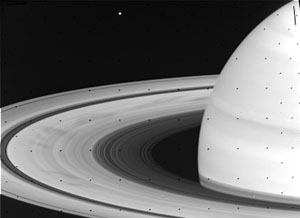
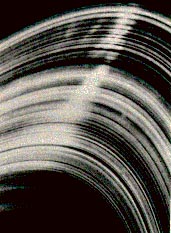
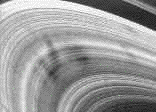
An animation showing the spokes.
Moons of Saturn
They orbit Saturn in the same direction that Saturn rotates, in the plane of Saturn's Equator.(Except for Phoebe, an outer moon which has a retrograde orbit. The Cassini spacecraft has photographed Phoebe.) There are over 30 moons.
The moons are synchronous, they point the same face toward Saturn, except for Hyperion and Phoebe. Hyperion has a chaotic rotation.
The moons were photographed by the Voyager spacecraft. However, some sides of some moons were not photographed, the Cassini spacecraft will fill-in the missing images.
The moons are mostly made from ice, water ice and other ices such as methane. The daytime temperatures of the surfaces of the moons is near 100K, or -170 °C.
The surfaces of the moons are cratered by meteorite impacts.
Some of the moons show "lava" flows, that is, flows of molten ice. Some moons show wrinkle ridges and cliffs due to shrinking of the surface while others show grooves due to expansion of the surface.
When liquid water freezes into ice it expands. The surface of a moon with a liquid ocean covered by ice will expand as the liquid freezes, the surface ice will then fracture. The usual ice we find at the surface of the earth is called ice 1. There are other types of water ice that form under high pressure, ice 3 is denser than liquid water. As liquid water freezes into ice 3 or as ice 1 changes into ice 3 the surface of the moon gets smaller and scarps and wrinkle ridges appear on its surface.
Demo Model the behavior of ice 3 by placing ice 1 cubes into 90% isopropyl alcohol. The ice 1 cubes will sink to the bottom of the alcohol liquid just as the ice 3 cubes would sink in liquid water.
Enigmatic Moon of Saturn
by Paul Doherty
Phoebe was photographed by Cassini as it approached Saturn.
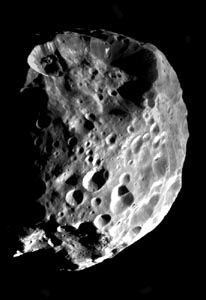
This website was presented as a webcast at the Exploratorium on July 2, 2004. My guest for the webcast was Dr. Eric Wegryn a planetary scientist and teacher from NASA.
Phoebe is the outermost moon of Saturn, 13 million km (8 million miles) from Saturn. It is 32 times further from Saturn than Earth's moon is from earth.
From Phoebe the planet Saturn would appear to be slightly larger (25% larger) than the earth's moon appears from earth.
( Here's the math: Saturn is 10 times the diameter of the earth and 40 times the diameter of the earth's moon, so since it is 32 times further away than the earth's moon is from earth it's angular size in the sky will be 40/32 = 1.25 times the angular size of the moon.)
The bright rings would make a disk 2.3 times the diameter of Saturn circling the planet. Imagine out moon circled by a bright disk making it twice as big in the sky. What a sight that would be!
Phoebe orbits Saturn in the opposite direction from all the other large moons. It is a retrograde moon. It takes 550.48 days to complete one orbit, about 1.5 earth years. It rotates every 9.6 hours. So from the surface there is one sunrise and one Saturn rise every 9.25 hours. It's orbit takes it 30 degrees above and below the rings giving it a good view of the rings.
Phoebe is 220 km (138 miles) in diameter, just large enough that its gravity can pull it into a nearly spherical shape.
Phoebe is dark, it reflects only 6% of the sunlight that hits it. We would say that it is a dark, dark gray. Particularly since the sunlight at Saturn's orbital distance starts out only 1% as bright as sunlight on earth. So the dim sunlight is only partly reflected.
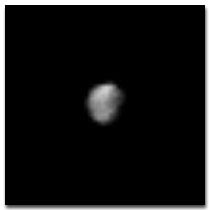
Due to Phoebe's strange orbit scientists think that it is a captured object, perhaps a member of the Kiuper belt. These asteroid-like objects orbit the sun in a cloud that is mostly beyond Neptune. But such objects are occasionally dropped into the inner solar system by stars passing close to the sun. One of them may have been captured by Saturn to become Phoebe. Thus the images of Phoebe would be the first images ever of a Kiuper belt object.
Mapping Phoebe's shape shows that it is more spherical than it appears in this photo. It is 220 km in diameter. The large crater at the top spans about 16 km from bottom to rim, It is nearly twice as deep as Mt. Everest is high.
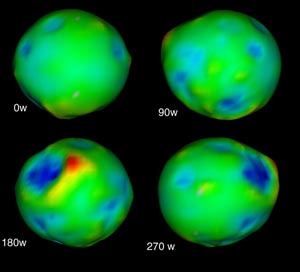
The spacecraft flew close to Phoebe an obtained some excellent views of the moon. There is a fresh looking crater in the top center of this image. In the enlarged image (click on this image to enlarge) you can see black and white layers near the rim of the crater. Perhaps the white layers are ice ejected from impacts elsewhere on Phoebe.
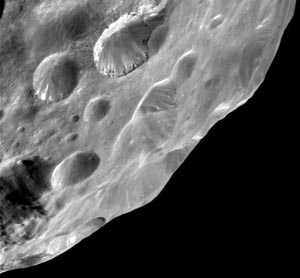
In the above image notice the white streak in the crater wall, perhaps this is ice uncovered by an avalanche.
Observing Phoebe with with an infrared camera reveals its temperature. It is a cold place! Temperatures on Phoebe range from 75 K (-324 F) before dawn to 107 K (-267 F) in the late morning. With cold temperatures like these, Phoebe is definitely a moon that would be comfortable for ice.
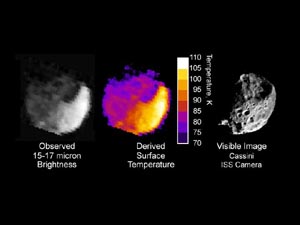
Planetary scientists are analyzing the flood of Data from Phoebe. They will soon know its density. Does it have the density of ice, 0.9 g/cm^3, or the density of rock 3.0 g/cm^3, or some other density indicating a strange composition. we'll soon know. We know its volume from the photographs and its mass from the gravitational deflection of the spacecraft. Combine these and you get the density = mass/ volume.
The infrared camera has also identified some of the materials on the surface of Phoebe: scientists have seen water ice, carbon dioxide ice, iron oxides, and as of now unknown minerals.
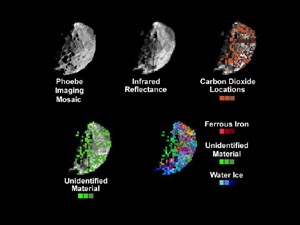
The data acquired by the Cassini spacecraft will be analyzed over the next decade to provide a much better understanding of Saturn, its satellites, its rings, and also of the origin of the solar system.
Phoebe may be a captured asteroid from the Kiuper belt, a "fossil" object from the beginnings of the solar system, time and hard work will tell.
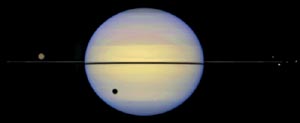
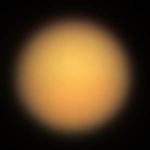
True color image of Titan from the Hubble space
telescope.
Titan was discovered by Christian Huygens in 1655. It is bigger than the planet Mercury and of all the moons of the solar system it is second to Ganymede in diameter, The diameter of Titan is 5150 km. (If you measure the diameter of Titan to the top of its 200 km high clouds then it becomes the largest moon in the solar system.) It is in orbit 1.2 million kilometers from Saturn. It orbits once in just under 16 days and is in synchronous rotation, it always keeps the same face pointing toward Saturn.
Demo Using our model of Saturn and its rings with a beachball Saturn 12 inches in diameter, the earth is a ball 1.1 inches in diameter and Titan is a ball 0.5 inches in diameter. It takes 23 Titans lined up to stretch across the diameter of Saturn. Two Titans almost stretch across the earth. Titan's orbits Saturn about 9 A-ring diameters from the planet. (actually 8.5) in our model Titan is 300 inches or 24 feet from Saturn's center.
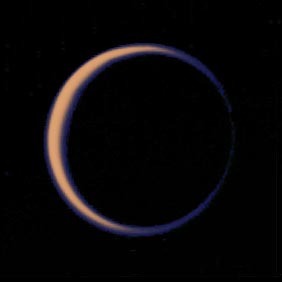
Titan is the only moon in the solar system with an atmosphere, and what an atmosphere it has! The pressure at the surface of Titan is 1.5 times the pressure on earth. The atmosphere is made of nitrogen with a few percent methane (CH4) and many interesting organic molecular impurities such as ethane (C2H6), propane (C3H8), acetylene (C2H2), hydrogen cyanide (HCN), and carbon monoxide (CO). The moon is covered with a red haze made from microscopic hydrocarbon droplets. The organic molecules are created when ultraviolet light from the sun breaks apart methane. Some released hydrogens escape into space, others react to create organic molecules. A similar thing happens to hydrocarbons from automobile exhaust in Los Angeles where solar ultraviolet creates hydrocarbon smog.
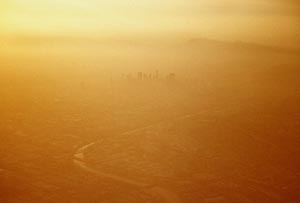
The surface temperature is 94 K, or -179 C (-290 °F). This is warmer than the temperature needed to make liquid nitrogen, 70 K. Methane is liquid at this temperature, and so is ethane. So Titan may have flammable seas (thank goodness there is no Oxygen around.) Higher in the atmosphere it becomes colder and nitrogen can form liquid drops and methane ice can form clouds.
Titan is far from the sun, so the sun is 100 times dimmer than on earth, it also has a smoggy atmosphere which further reduces the light. The surface of Titan is 1000 times dimmer than the surface of the earth.
Demo Peep astronaut on Titan. It is cold on Titan. Take a Peep astronaut to Titan. Immerse the Peep in liquid nitrogen then tap it with a hammer. The Peep will shatter.
Demo Cold Finger. Put a hand into a latex glove. One finger of the glove is full of a hot dog, unknown to the audience. Stick the "finger" which is actually the hot dog into the liquid nitrogen. To show the effects of the cold temperatures of Titan on a human, Hit the finger with a hammer and shatter it. Then confess to the audience that it was a hot dog.
Demo Even though there are hydrocarbon molecules on Titan they will not burn. Put liquid nitrogen into a tank as it boils it will drive out the earth's atmospheric oxygen. Put a burning cigarette lighter into the tank. Notice that the lighter goes out.
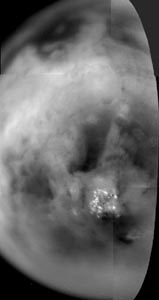
Titan is covered by a 200 km thick haze, which completely hides the surface. We have seen the surface using the Hubbell telescope using infrared light that penetrates the haze. We have looked at the surface with radar from earth and found a bright region, which is rough and therefore not an ocean. We will see the surface with radar on the Cassini spacecraft.
Demo Use a thermal infrared camera. Have a person put a bag over their head. Look at them in visible light and you cannot see their face. Look and them in infrared light and the bag becomes transparent. You can see their face. It is the same with Titan infrared light passes through the haze while visible light is absorbed.
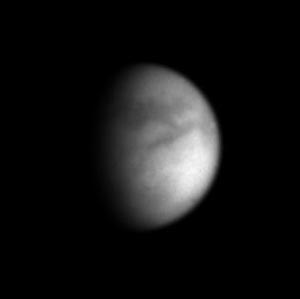
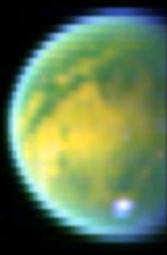
Combining images in several wavelengths gives this color image of
Titan's surface This image is made by the VIMS instrument. The white
spot is made of methane ice clouds
Demo Put a steel bowl on a ringstand. Pour some liquid nitrogen into the bowl. Oxygen will condense on the outside of the bowl, run down under gravity and drop off the bottom. If one of the drops of LOX, liquid oxygen, hits a smoldering splint of wood the splint will burst into flame.
On Titan gasses that are cooled below their condensation temperature turn into liquid drops and create clouds, rain, and maybe rivers or oceans. Gasses that are below their freezing point make ice crystals and snow which may fall on the surface as drifts.
Titan has a density 1.9 times water. This means that it is about half ice and half rock. We find the density by measuring how much gravitational pull it exerts on the spacecraft which gives the mass, then we use photgraphs to compute the volume. Density is mass divided by volume.
Other Moons
Iapetus has one face that is very black and another that is bright white. In the book 2001 a Space Odyssey a spacecraft is sent to Iapetus where the star gate is located. The dark side of Iapetus may be due to material ejected from Phoebe.
Enceladus is the most reflective object in the solar system, its albedo is 1, which means it reflects 100% of the incident sunlight.
Prometheus is the least dense object in the solar system, 0.25 the density of water.
The Cassini Spacecraft
The spacecraft is the size of a city bus. The Huygens probe is shaped like a wok and is the size of a phonebooth. Picture a tardis-like phone booth tucked into a wok being ejected from a city bus.
Onboard there is the VIMS, Visible Infrared Mapping Spectrometer. It makes images in hundreds of different wavelengths which will allow scientists to identify the materials that Saturn, its rings, and its moons are made of.
Demo Saturn can be modeled by placing a 14 inch diameter beachball inside a 32 inch diameter Beamo flying ring. The outer diameter of the bright rings is 2.3 times the diameter of Saturn.
Demo The equatorial diameter of Saturn is 9.4 times the diameter of the earth. In our model 9 ping pong balls line up across the diameter of the beachball, thus the ping pong ball to beachball ratio shows the relative sizes of the earth and Saturn.
This means that the volume of Saturn is about 93 = 730 times the volume of the earth.
Demo If you find a hollow spherical shell that is 4 inches in diameter (they are sold at a craft stores and split in half), you can fill each half with 1/2 inch diameter marbles. However the marbles leave some empty space as they fill it. Since the outer sphere is 8 times the diameter of the marbles it has 83 = 512 times the volume of each marble. However the spheres only fill part of the volume and so about 100 marbles fit into each half of the sphere. Random packing of spheres fills up about 64% of the volume. A large number of earths would fit inside Saturn.
Saturn is a planet made mostly of Hydrogen and Helium.
It has a low density, the density of Saturn is 0.69 g/cm^3. It is less dense than water.
Which means that if you put Saturn in a bathtub full of water it would float...of course if you then rained the tub Saturn might leave a bathtub ring.Eric Wegryn points out that if you actually did put Saturn in a large tub of water the core would sink through the fluffy low density atmosphere and it would be left behind in the tub not the ring.
Saturn is made of 97% H2, 3% He plus impurities.
Demo: Hydrogen Balloon, feel the lightness of the balloon. Ignite the balloon and allow it to react with oxygen. Bang! There is no oxygen on Saturn the hydrogen cannot go bang.
As you descend into Saturn the pressure and the density increase. The temperature starts out high then decreases to a minimum and then increases again. The center of Saturn is much hotter than the surface of the sun.
Saturn is a fluid throughout. There is no solid surface on Saturn. At high elevations the atmosphere is hot and thin, as we descend into the planet the atmosphere gets thicker and colder. At a pressure of 0.1 of the pressure at the surface of the earth we reach the cloud tops on Saturn. No one knows what chemical gives the clouds on Saturn their color. Descend further and the atmosphere cools some more, when the atmosphere is the same density as the surface of the earth it has a temperature of 140 K. The temperature decreases to a minimum of 80 K and then starts to increase once again. Saturn gives out more energy than it receives from the sun. So the center of Saturn must be warmer than the surface.
Saturn Rotates in a little over 10 hours.
The rapid rotation creates a large equatorial bulge. The equatorial bulge helps hold the rings in the plane of the equator of Saturn.(Return to rings)
Demo Spin a Koosh, If you spin a Kooshball as you throw it into the air it will assume a shape with an equatorial bulge similar to the equatorial bulge of a rotating planet.
Saturn also has lesser bulging rings at 45 degrees north and 45 degrees south latitude.
Planets are made from an alphabet of shapes, the sphere, the equatorial bulge, the pear shape and more. The shapes are known as the spherical Legendre Polynomials and are also the alphabet of shapes used to describe the shapes of atomic orbitals. Here is a draft of an article that sketches out the mathematics of the shapes of planets. Planet Shapes.
Saturn has bands in its clouds parallel to the equator, the light bands are zones, the dark ones are belts. Dark cyclonic storms blow around Saturn and appear in movies.
Sunlight is only 1% as bright at Saturn (compared to earth)
Demo Use the turbulent orb to model the belts and zones of Saturn's clouds and to show laminar and turbulent flow.
Lightning has been detected on Saturn.
Saturn has a magnetic field which is about 2/3 as strong as the magnetic field of the earth (measured at the surface of the earth and at the cloud tops of Saturn.
The magnetic field gives Saturn a magnetosphere. The magnetic field of Saturn bends the path of charged particles from the sun. It also creates radiation belts.
Demo Fill a 4 inch diameter sphere with a 1.5 inch long stack of neodymium magnets held in the center with clay. Hold a compass outside the sphere and notice the range over which the magnetic field of the model is stronger than the magnetic field of the earth. In the same way Saturn's magnetic field is stronger near Saturn than the magnetic field of the sun. The region in which the magnetic field of Saturn is stronger than the solar magnetic field makes the magnetosphere of Saturn.
Demo Move the model of Saturn near a small oscilloscope with a beam of electrons creating a spot in the center of the display screen. The magnets in the model will deflect the beam. In the same way, the magnetic field of Saturn deflects moving charges in the vicinity of Saturn.
Ideas
Saturn is a spherical gnomon set amidst the sundial of the rings. Movie from Starry Night.
The Romans Saturn's day is our Saturday
Saturnalia a seven day Roman feast around winter solstice,
Data from www.solarviews.com, checked with The Cambridge Planetary
Handbook
Mass 5.688 E 26 kg, 95.181 Mearth
radius equator 60,268 km, or 9.4494 r earth
oblateness 0.1076
mean density 0.69 g/cm^3
distance from sun 1.4294 E 9 km, 9.5388 AU, 80 light minutes
rotation 10.233 hr, 10 hr 14 m
orbit 29.458 yr
tilt of axis 25.33°
equatorial surface gravity 9.05 m/s^2, polar 10.14 m/s^2
Diameter of outside of A ring is 2.3 times the diameter of Saturn.
cloud temp -125 C
Hydrogen 97% Helium 3%, methane 0.2%, water 0.1%, ammonia 0.01%
Aerosols: Ammonia ice, water ice, ammonia hydrosulfide
magnetic field tilt 1°, strength is about 2/3 that of Earth at the "surface"
sun subtends 0.056 ° about 1/10 as big as the sun viewed from Earth.
sunlight on Saturn is 1% as bright as on earth. (7 f stops dimmer)
|
Scientific Explorations with Paul Doherty |
|
9 July 2004 |